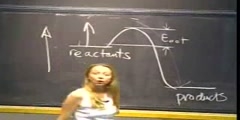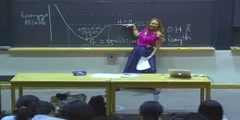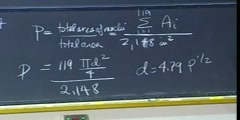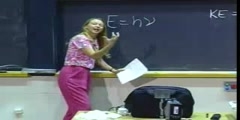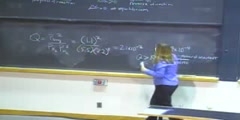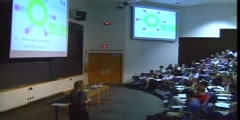Chemical Science - Hydrogen Atom Wavefunctions - Lecture 7
Principles of Chemical Science/n * Email this page/nVideo Lectures - Lecture 7/nTopics covered: /nHydrogen Atom Wavefunctions/nInstructor: /nProf. Sylvia Ceyer/nTranscript - Lecture 7/nAll right. Today, in particular the second half of the lecture today, we're going to do some of the hardest concepts that we've done so far, and also some of the most important concepts that we've done so far./nI just want to give you a heads-up on that. Last time we had we had solved the Schrödinger equation for the binding energies of the electron to the nucleus. And that means if I write the generic Schrödinger equation down here, what we found was what this E was./nAnd we found that it had a nice analytical form, that the allowed binding energies were quantized. They were quantized by that principle quantum number n. And so we can write those allowed energies as En=-Rh/n2./nSo, n is this principle quantum number. And n runs from 1, 2 all the way up to infinity. Today what we're going to do is we're going to look at the solutions to the Schrödinger equation for this, for the wave function, for the wave./nAnd remember we said that the wave, in some way, represents our electron. And today we are going to talk about exactly what is the meaning of the wave function. But, before we do that, I have to tell you that when you go to solve the Schrödinger equation for the wave function here what happens is that two more quantum numbers pop out./nAnd one of the quantum numbers that pop out in the solution for the wave function is a quantum number we call l. l is the angular momentum quantum number. It's called the angular momentum quantum number because it, in fact, determines how much angular momentum the electron has./nIt is a quantum number, which means it has allowed values, very specific values. The allowed values of l are the following. They are zero. Unlike n, the lowest value that l can have is zero. 0, 1, 2, 3 all the way up, but it has got a limit./nl has got a limit. The limit is n-1. So l can never be larger than n-1. It's tied to the principal quantum number. Why is it tied to the principal quantum number? Well, notice that only the principle quantum number tells you about the binding energy./nIt tells you about the total energy of this electron interacting with the nucleus. Whereas, the quantum number l, the angular momentum number, it determines how much angular momentum the electron has./nAnd, in a classical picture, you may be familiar with the fact that if something has got angular moment it has rotational kinetic energy. And since the total energy is that rotational kinetic energy plus potential energy, well, then l is never going to be as large as n because, otherwise, then the electron would only have rotational kinetic energy and no potential energy./nAnd that wouldn't work, right? So, that's why there is a limit here to l that is as large as n-1. Because you have to leave some energy to be potential energy here. And then, finally, we have the third quantum number./nAnd that third quantum number we call m. It is the magnetic quantum number. And it is called magnetic because, in fact, it does determine the behavior of an atom in a magnetic field. Although, we're actually not going to take a look at that./nBut more specifically what m is, is the z component of the angular momentum. And its allowed values are the following. n=0, so just like l it can have a value of zero, +1, +2 all the way up to +l. Look at this./nThe magnetic quantum number is tied to the angular momentum quantum number. Why? Well, because this is the z component of the angular momentum, or it dictates the z component of the angular momentum./nl dictated the total angular momentum. Well, the z component of the angular momentum is never going to be bigger than the total angular momentum, so that is why n is tied to l. And, of course, when we talk about a component, we're going to have a direction here, too./nAnd so these quantum numbers m can be zero plus/minus 1, plus/minus 2 all the way down to plus/minus l. So, that is it. We've got to have three quantum numbers here to really explain our system. The reason we have three quantum numbers is because we have a 3-dimensional system./nSo, it a little bit makes sense that you've got to have three quantum numbers to really describe the hydrogen atom here. And then the consequence of having these three quantum numbers, when you solve that differential equation, remember we talked last time where those quantum numbers come from when you solve a differential equation, as you will when you do 18.03./nThose quantum numbers come from imposing these boundary conditions on your differential equation. Those boundary conditions make a generic or general differential equation specific to the problem you're working on./nAnd when you do that, those quantum numbers fall right out. And, again, we believe them to be true because they agree with our observations of nature. Now we've got to deal with three quantum numbers that are going to have to then describe these states that we talked about last time./nFor example, we talked about the ground state, n=1 here. But what I'm saying to you now is that there are a few more quantum numbers that we have to add to label that ground state correctly. Or, to label it completely./nAnd, as I just said, if n=1, well, then we learned about l here. l, the largest value it can have, is n-1. So, we have a quantum number l that is tied here. And that quantum number is zero. l=0./nAnd we just learned that we have a third quantum number m. And the greatest value that m can have is +l. So, if l=0 then m=0. And so, therefore, our ground state, the label that we have got to put to our ground state is the 1, 0, 0 state./nSo, we're expanding our definition of the label of that state. Last time it was n=1. Now it is 1, 0, 0. And, if we have an electron in that 1, 0, 0 state, then we're going to have a wave function that describes that electron./nThat electron is going to be represented by a wave function. That wave function is psi 1, 0, 0. The energy of that 1, 0, 0 state is minus the Rydberg constant over 12. Just like we had last time. Now, suppose we had the first excited state, which was n=2, as we looked at last time./nIf n=2, what is the smallest value that l can have? Zero. And if l=0, what is the only value that m can have? Zero. We have now a state that is the 2, 0, 0 state. And, if you have an electron in the 2, 0, 0 state, we're going to describe that electron by a wave function that we're going to label psi 2, 0, 0./nAnd the energy of that state, we saw last time, minus the Rydberg constant over 4. But n=2, we also just saw that the quantum number l can have another value. And that is one. And if l=1, what is the largest value that m can have? One./nAnd so we've got another state here. It's the 2, 1, 1 state. And, if you've got an electron in the 2, 1, 1 state, that electron is going to be described by a wave function that we're going to call the psi 2, 1, 1 state, the psi 2, 1, 1 wave function./nNotice that the energy of this state is still minus the Rydberg constant over 4. It is the same as the 2, 0, 0 state. These two states are said to be degenerate. Degenerate means have the same energy./nIf n=2, then l=1. What's the next smaller value that m can have? Zero. So, we have a 2, 1, 0 state. If an electron is in that state, the wave function describing that electron is 2, 1, 0. Again, the energy here is minus the Rydberg constant over 4./nSame energy because the energy is only dictated by the n quantum number. And then, finally, what's the smallest value m can be if you have n=2, l=1? Negative one. So, we have a 2, 1, -1 state. The wave function describing that electron in that state is the psi 2, 1, -1 wave function./nNow, I described the electrons in these states by these wave functions ?. But there is another language, as I alluded to last time. Another language that is used to describe the wave functions. And that language is this orbital language./nWe talked last time how an orbital is nothing other than a wave function. It is the solution to the Schrödinger equation for the hydrogen atom. It is actually the spatial part of the wave function, meaning there is another part of the wave function called the spin part./nBut we will look at that a little bit later. And how are we going to label these wave functions in the orbital language? Well, we're going to label them by the principle quantum number n. And, of course, the angular momentum quantum number l and then a subscript here m for the magnetic quantum number./nBut what we do is instead of using the actual value of l, we have a letter code. For example, if l=0, we call that the s-orbital. In the case of the 1, 0, 0 state, if you have an electron in that state, the wave function that describes that electron is the 1s-orbital or the psi 1, 0, 0 wave function./nThis is the principal quantum number. This is the code s for l=0. And then, likewise, in the 2, 0, 0 state, the wave function that describes that electron will be 2s. Because here is the n=2 and then our code for l=0 is s./nNow, when l=1, again, we don't use l=1, we use a letter. That letter is p. We call that a p-orbital. This state here, the 2, 1, 1 state is going to be a 2p wave function, or the electron in it is going to be represented by this 2p wave function./nThe same thing for this state. They're all 2p because l=1 for all these three states and n=2. Now, if I had here an angular momentum quantum number of 2, we'd call that a d-orbital. If I had one that l=3, I would call that an f-orbital, and so on and so forth./nBut now, what I haven't said anything about yet, is the m quantum number here. Again, we've got a code for this. We're actually not going to use the number m. We are going to use some letters. And the code is that when m=0 we are going to put a z subscript here on this p-orbital designation, when m=0, when m=1 we're going to be an x subscript on this p-orbital designation and when m=-1 we're going to put a y subscript on this p-orbital designation./nNow, I should tell you that what I just did here is not actually correct. In other words, m=1 isn't really the x subscript and m=-1 isn't really the y subscript. The reason is because these two p wave functions, when m=1 and m=-1, they're complex functions./nAnd what we do is we do some linear combination of the m=1 and m=-1 wave functions to get what we call the px wave function and the py wave function. One is a plus linear combination. One is a negative linear combination./nYou're not responsible for that. Therefore, you are not responsible for knowing when m=1 we have an x and m=-1 we have a y. You are responsible for knowing when m=0, you have a x subscript here. Now, I should make one other point here./nAnd that is you see I don't have a subscript here for m on the s-orbitals. Well, in an s state, when l=0, there is only one possible value of m which is zero. And so we just leave out that subscript./nWe don't put a z here on the s designation. What does this mean, the fact that we've got these extra quantum numbers? Well, it means we have extra states. And these states, actually, though have the same energies that we saw last time./nBut let's try to expand that a little bit and draw an energy level diagram so that we really understand what is going on. Here is my energy level diagram, energy going up this way. And when n=1 then our quantum numbers, the most complete description here is the 1, 0, 0 state./nAnd the electron in that state has the wave function that is represents that electron. We call that the 1s wave function. That is the energy. When n=2 you see now we have now four different states that are all the same energy, 2s, 2py, 2pz, 2px./nThey have all the same energy. They are degenerate. Again, degenerate means having the same energy. And, in general, what we've got is n2 degenerate states at each end. So, these have all the same energy./nThey differ in how much angular momentum the electron has and how much angular momentum the electron has in the z direction if it were in the presence of a magnetic field. But they have the same energy because energy is only dictated by the n quantum number./nNow, when n=3, how many degenerate states do we have? Nine. Here they are. The energy is -1/9, the Rydberg constant. Here are the nine degenerate states. 3s, 3py, 3pz, 3px. That pattern just reproduces 2s, 2py, 2pz, 2px, so we won't go through those./nBut now we've got some extra states here. Again, their quantum numbers are all 3 for n, but when n=3 the largest value of l=2. And so all of these states here have l=2. And our code for l=2 where these d-state./nIf you have an electron in those states, it's represented by a 3d wave function. But now the reason these 3d wave functions differ is because they have different amounts of angular momentum in the x component./nThey have different values of m. If n=3, l=2. This smallest value that m can have is -2, right? And then I am going to just call, when m=-2, xy here in the subscript. When m=-1, I am going to put yz in this subscript./nWhen m=0, I am going to put z squared in this subscript. That is going to be my code for m=0. In the case of 3d orbitals, the 3d wave functions, I am going to put a z squared in that subscript. Then when m=1, I am putting an xz./nAnd when m=2 an x2 ñ y2. Again, you are now responsible for knowing when m=-2, this is xy, when m=-1, this is yz, because that isn't strictly correct. Again, we've complex functions. We're making them real./nAnd we're taking linear combinations. You are responsible for knowing that when m=0 in a 3d state, this subscript here is z2. When m=0 in a 2p state, that's a z subscript. When m=0 in a 3d state, that's a z2 subscript./nYou will look at these 3d states more in detail when we talk about transition metals in the second half of the course with Professor Drennan. So, that's our energy level diagram. Everybody OK with this? Questions? OK./nWe've found these two other quantum numbers. We've got three quantum numbers. We know how to label the states and we know how to label the wave functions that describe the electrons in these states, but now it's time to talk about what a wave function really means or how exactly does a wave function represent this particle, this electron? How do you interpret the wave function? And the answer is you don't./nThe answer is that that wave function is the wave function. It is one of these concepts that you cannot or you don't have a ready classical analogy. It's one of these concepts that you don't experience in your everyday life, and so you cannot say it's like this, because within your everyday world there is nothing to draw a correct analogy to./nHowever, the wave function squared does have a physical interpretation that is meaningful in your environment. And that is that this wave function squared, and let me just write it out here now in its full glory./nRemember, this wave function, we're going to denote by three quantum numbers, n, l and m, and it's a function of r, theta, phi. If I take this wave function and I square it, the interpretation of that wave function squared is that it is the probability density./nThat is it is a probability per unit volume. A density is always per unit volume. So, it's a probability per unit volume. Where did that come from? Good question. Soon after Schrödinger wrote down his wave equations, there was a lot of discussion in the scientific community about what does psi really mean? What is the interpretation of psi? And there were a lot of interpretations given, a lot of explanations given, but finally one very cleaver scientist by the name of Max Born said if I think of psi squared as a probability density then I can understand the predictions that the Schrödinger equation makes./nSo, psi squared is an interpretation. He said if I think of psi squared as the probability per unit volume and then I go an analyze all of the results of solving the Schrödinger equation in terms of that concept, that it is a probability density, then things make sense./nAnd those predictions agree with my observations. You know what? That's it. There is no derivation here of psi squared. Psi squared is just that. It is an assumption. It is an interpretation. But, you know what, you use that interpretation and that makes predictions that agree with our observations./nAnd there are no observations that even hint that that interpretation isn't correct. But that is it. You don't go any further. There's no derivation of this. This is an interpretation. It is a probability density./nWell, this gentleman, Max Born, was a really cleaver scientist. Max Born is the same Born of something called the Born-Oppenheimer approximation that maybe some of you know about. It is the same Borne of the distorted wave Born approximation, which probably nobody knows about./nBut I've got to tell you that despite the fact that Max Born has all of these accomplishments, the interpretation of size squared is a probability density, the Born-Oppenheimer approximation, the distorted wave Born approximation, despite all of those accomplishments, he is best known for being the grandfather of Olivia Newton-John./n[LAUGHTER] That is true. Actually, a couple of weeks ago in the Boston Globe, and I guess papers throughout the country, has a magazine called Parade Magazine. And it actually had an article about Olivia Newton-John, if somebody is going who's Olivia Newton-John, that's just an indication of how old I am./nOlivia Newton-John is a single. Grease. It was interesting. The Boston Globe a few weeks ago in Parade Magazine, there was an article on her. And it mentioned that her grandfather was Max Born. Didn't say anything about Max Born after that, but did mention that./nAll right. Now you know what size squared is. It's a probability density. You and I, we can understand that. Size squared, we can understand that. It's a probability density. But what I want to really emphasize here is that it is a probability density./nIt is not probability. It is probability per unit volume. That's important. In a moment, we're going to look at a quantity that is a probability. But this is a probability density. You've got to get the units correct here./nHow can we use that to understand something about where the electron is in an atom? Well, let's do that on the slide there. Kill those lights. Probability density. What I am going to do is I am going to represent the probability density here by a density dot diagram./nI am going to take my 1s-orbital, my 1s wave function, or my psi 1, 0, 0 wave function, and I am going to square it. And then I'm going to take the results of that squared function and plot it as a dot diagram here where the density of the dots is proportional to the probability density./nSo, the darker the dots the higher the probability density. And, as the dots get more and more dispersed, the probability density is getting smaller. I did that for my 1s wave function, squared the 1s wave function and plotted it here on x, y, z./nOh, I got the x and the y turned around. That's all right. I plotted it here. What you can see is that the probability density is a maximum at the origin, at the nucleus, and that it decays equally in all directions./nIt is isotropic. There is no angular dependence. It's spherically symmetric. And that you can also see nicely if you look at the actual plot of the wave function. Not size squared now. The wave function, which I am plotting here./nThis is the wave function and I am plotting it versus r. Actually, what I am plotting it here is as r over this something called the ìa knotî. aO is a constant. aO is called the Bohr radius. aO is about a half an angstrom./nI will explain to you where aO comes from in a little bit, but right now it's just a constant. Here is the actual form of that wave function. It's pretty simple. This stuff right in here, this is all a constant./nJust one over pi aO cubed. I said this was about a half an angstrom. And then the important part is right here. It's a decaying exponential in r, e to the minus r over a knot. And so the wave function starts out at some high finite value at r=0 and it drops off exponentially as r goes to infinity./nThat's what we're plotting. And you can see that reflected here. When you square this you can see that reflected in that probability density. What does it tell me? It tells me that the probability density is highest at the nucleus and drops off in an exponential fashion equally in all directions./nThis is spherically symmetric. We're going to say some more about where is the electron in a moment after we go through not only 1s, but 2s and 3s. Here I plotted the 2s wave function. I took the 2s wave function, I squared it, so I got values as a function of r./nAnd, again, the density of the dots is proportional to that wave function squared. And, again, what do you see? You see that the probability density is largest at the origin. And that it decays again equally in all directions because it's spherically symmetric./nAnd it decays so much that all of a sudden you get to some value of r and there is no probability density. And then, as you get to the large value of r, well, the probability density increases again right here./nAnd then it finally decays as you get to larger values of r. What this wave function has in it here is something called a node. There is a value of r right in here where there is no probability density./nThat value of r, in terms of this constant, aO, is two times aO. We call that a radial node. You can see that radial node very easily if you look at a plot of the actual wave function. We're not squaring the wave./nThis is the wave function. Here it is. Here is the form for it. At r is equal to zero, it's some finite large value, and it decreases. It decreases until we get to a value of zero, psi=0. Let me just draw that here on the board./nI am plotting here the psi 2, 0, 0 wave function, the 2s wave function. I am plotting it as a function of r. What it looks like is that at r=0, it starts out as some high finite value and it drops./nAnd it actually goes through a zero. And it drops and it keeps dropping until some point and becomes negative. And then it turns around and it approaches a zero again. And so at very large r the wave function is zero./nRight here, where this wave function becomes zero, that's what we call a radial node, r=2aO. This is a radial node. It is a value of r that makes the wave function be equal to zero. If you wanted to solve for the radial node, you'd simply take the functional form for 2s, which is º(ΩpaO3)Ω (2-r/aO) e-r/2aO./nIf you wanted to solve for the value of r at which this node occurs, you set everything equal to zero. You solve for r. This goes away. This stuff is just a constant. It goes away. You have 2-r/aO and that's equal to zero./nYou can see, when you solve this, that r is equal to 2aO. That is the value of r at which you have a node. Now, notice this. At r=aO the wave function changes sign. It was positive up here. It is negative down here./nThat is a general characteristic. When the wave function goes through a node, the wave function changes sign. Why is that important? Well, have you maybe in high school -- We haven't talked about p orbitals yet./nBut remember you put sometimes a plus sign on a p orbital and a minus sign on a p orbital? Did you do that? Yeah? Well, that plus and the minus represented the sign of the amplitude of the wave function./nPlus meant it had a positive amplitude. Minus meant it had a negative amplitude. That's what it meant. Sometimes you may have called it the phase of the wave function. You know why that's important, the phase of the wave function? It's important because when you go to do chemical bonding, when you bring up two atoms and you are overlapping two atoms and you're overlapping the wave functions that have the same sign, you've got constructive interference and you have chemical bonding./nIf you come in and you overlap two wave functions that have opposite signs, you've got destructive interference and you've got no chemical bonding. We're going to see that later, but that's why that's so important, is the amplitude of the wave function here and these nodes./nLet's look at the 3s wave function. Here we are back up here. Plotted the 3s wave function. The probability density of the 3s wave function. Again, what do you see? You see right in the center, probability density is the largest./nAnd then, as r increases, that probability density drops off. However, you get to a value of r right here where you've got another node, another value of r that makes the wave function be equal to zero./nAnd then, as you increase r, the wave function again, the probability density increases. It increases because look right here. You're getting a more and more negative value. If you square a negative value you're going to get a large positive value./nThat is what this high probability density reflects. It reflects the fact that the wave function right in this area has a large negative value. You square it. You're going to get a large positive value./nAnd then, as you increase r again, well, again you get another value of r where you have a node. The wave function goes to zero. Here's that point right there. Here is psi=0. Wave function zero. And then, as you increase r, well, again, the probability density goes up./nWhy? Because the wave function increased right here. See that? Square it. It's going to go up. And then it turns around and goes to zero and this decays. If you wanted to solve for this radial node and this radial node, which I will let you do, you take the functional form, set it equal to zero and solve for r./nThat is easy. All of this stuff is a constant. This goes away. It's the quadratic and you're solving for the roots. So what have we learned? We've learned the 1s wave function, 2s wave function, 3s wave function./nAnd, in fact, all s wave functions or l=0 wave function, all of them are spherically symmetric. They have no angular dependence. Remember we said that in general the wave function depends on r, theta and phi./nS wave functions have no theta and phi dependence in them, unlike p wave function, which we will look at very soon. Also, very important here, the probability density of all s wave functions is a finite value at r=0./nThose are the two important things. And you know how to solve now for a radial node. You set the wave function equal to zero, solve for the value of r that makes the wave function zero. Now, we have to continue this discussion so we can start to talk about the probability of finding an electron some distance from the nucleus./nWe just talked about probability density. We haven't talked about probability yet. And here comes probability. We're going to plot something and we're going to talk about something called the radial probability distribution./nWhat is that? Well, the radial probability distribution is the probability of finding an electron in a shell. You know what a shell is. A shell is a sphere, but the sphere is hollow except that at the diameter or at the circumference you have a thin coating./nThat thinness has got a dr to it. It has a thickness to it. I'm sorry. It's a probability. This radial probability distribution is the probability of finding an electron in a shell of radius r and a thickness dr./nLet me try to explain that some more. Here is this gray part. That's my probability density that I drew before, the dot diagram. This is a 1s wave function. This is a probability density for the 1s wave function, ? 1, 0, 0 squared./nThis blue thing here is a spherical shell. It has some radius here r. It also has some thickness dr. You see I cut away here, this thickness dr? The radial probability distribution is the probability of finding this electron in this spherical shell that is of radius r and thickness dr./nSo, it's the probability of finding the electron at some distance r to r plus dr. That's the radial probability distribution. Now, I want you to notice what is the volume here of this spherical shell? Well, that volume is just 4pi r square, the surface area of that spherical shell, times the thickness which we're going to call dr./nThat is the volume. Now, if I wanted a probability of finding my electron in an s wave function some distance from the nucleus, some distance r to r+dr, what am I going to do? Well, I'm going to take my probability density, which I said was psi squared probability per unit volume./nI am going to multiply it by a volume. Then I am going to get a probability of finding my electron some distance r to r+dr from the nucleus. And that is what we're going to talk about on Monday, is the actual probability of finding the electron from the nucleus./nSee you on Monday.
Channels: Chemistry (General)
Tags: Hydrogen Atom Wavefunctions
Uploaded by: mitlectures ( Send Message ) on 16-04-2009.
Duration: 49m 59s


